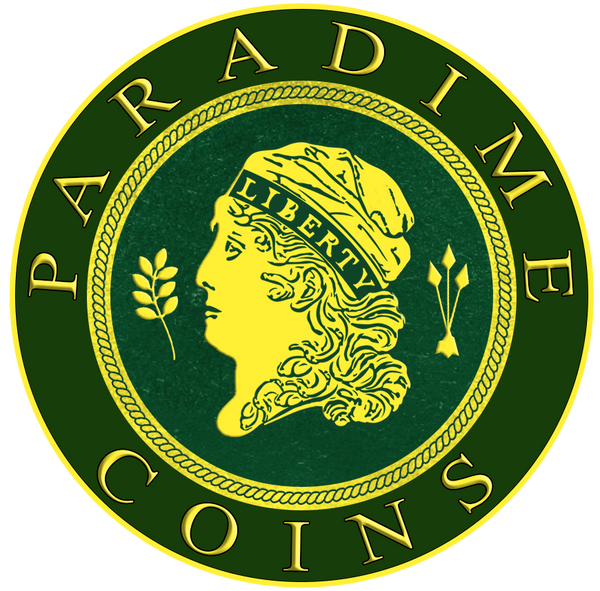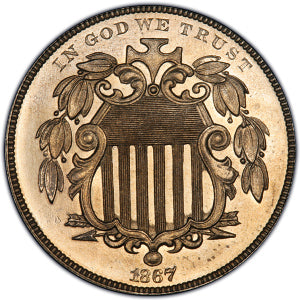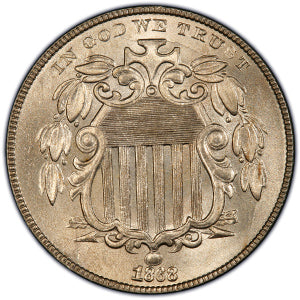Collection: Shield Nickel (1866 - 1883)
No products found
View All Inventory
Shield Nickel (1866–1883): A Unique Post-Civil War Coin
The Shield Nickel, introduced in 1866, was the first five-cent coin made of nickel alloy. Its creation marked a significant step in U.S. coinage history as it replaced the silver half dime, aligning with the nation's efforts to transition to base metal ... Read More
Shield Nickel (1866–1883): A Unique Post-Civil War Coin
The Shield Nickel, introduced in 1866, was the first five-cent coin made of nickel alloy. Its creation marked a significant step in U.S. coinage history as it replaced the silver half dime, aligning with the nation's efforts to transition to base metal coins during and after the Civil War. Designed by James B. Longacre, the Shield Nickel featured intricate motifs that evolved over time.
Key Features and Specifications
- Designer: James B. Longacre
- Composition: 75% copper, 25% nickel
- Diameter: 20.5 mm
- Weight: 5.00 grams
- Edge: Plain
-
Mintage:
- With Rays (1866–1867): 16,761,500 (Business Strikes); 500 (Proofs)
- Without Rays (1867–1883): 111,256,110 (Business Strikes); 31,000 (Proofs)
Historical Background
The Shield Nickel emerged during the Civil War era, a time when hoarding of silver and gold coins left the U.S. economy in dire need of durable, affordable coinage. The five-cent nickel alloy coin, introduced in 1866, replaced the half dime and became a practical solution for commerce.
Initially, the "With Rays" design included 13 rays on the reverse, surrounding a large numeral "5." However, striking difficulties led to the removal of the rays in 1867, resulting in the "Without Rays" design that continued through 1883.
Design Highlights
-
Obverse:
- A shield symbolizing strength and unity, flanked by a wreath, with IN GOD WE TRUST inscribed above.
-
Reverse:
- The numeral 5 encircled by 13 stars, with UNITED STATES OF AMERICA and CENTS around the border.
- Rays were present (1866–1867) but later removed due to striking challenges.
Collectability and Rarities
The Shield Nickel series offers opportunities for collectors at various levels, from common dates to rare varieties:
-
With Rays (1866–1867):
- 1867 With Rays Proof: One of the rarest Proof coins in U.S. history, with fewer than 20 known examples.
- Business strikes from this period are scarce in high grades due to striking difficulties and die wear.
-
Without Rays (1867–1883):
- Key dates include 1871 and the Proof-only issues of 1877 and 1878.
- Business strikes from 1879 to 1881 are also challenging to find, adding intrigue for advanced collectors.
Challenges in Production and Striking
The hard nickel alloy caused rapid die wear, resulting in weakly struck coins, especially in the With Rays design. Die breakage and recut dates, such as the 1867 Doubled Date, add variety and appeal for numismatists.
Collecting Strategies
-
By Type:
- Collect both the With Rays (1866–1867) and Without Rays (1867–1883) designs for a comprehensive type set.
-
By Date:
- Assemble a complete date set, including the rare 1867 With Rays Proof and Proof-only issues like 1877 and 1878.
-
For Type Sets:
- A single representative coin, such as an 1866 or 1867 With Rays, is a popular choice for U.S. type set collectors.
Tips for Collectors
- Look for well-struck examples, as weak strikes are common, especially in the early years.
- Proof coins, particularly from the later years, offer better availability and quality, making them excellent options for collectors.
- Avoid cleaned or heavily worn coins, as these diminish value and appeal.
Why Collect Shield Nickels?
The Shield Nickel series represents a pivotal period in U.S. history, bridging the gap between Civil War coin shortages and the return of silver coinage. Its unique designs, historical context, and manageable length make it an exciting and accessible pursuit for numismatists.
Explore Shield Nickels at ParadimeCoins.com
At ParadimeCoins.com, we offer a curated selection of Shield Nickels, including key dates, Proofs, and high-grade specimens. Whether you're completing a type set or building a date collection, we provide high-quality, certified coins to enhance your portfolio. Start exploring this fascinating series today!
... Read Less






